(Click photos for a larger view)
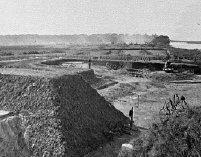 My wife Mary Ellen and I were married on July 26, 1949 at St. Paul's Episcopal Church in Savannah, Georgia. I had just accepted a regular commission as a Second Lieutenant in the US Air Force. We went on our honeymoon to western North Carolina, until my orders came, or we ran out of money, which ever came first. Fortunately my orders to report to the Air Force Tactical School in Panama City, Florida arrived in time, and we drove down to Tyndall Air Force Base for the beginning of the Squadron Officers' Course. I graduated from the school just before Christmas, with orders to report to the Second Bomb Wing at Chatham Air Force Base in Savannah.
My wife Mary Ellen and I were married on July 26, 1949 at St. Paul's Episcopal Church in Savannah, Georgia. I had just accepted a regular commission as a Second Lieutenant in the US Air Force. We went on our honeymoon to western North Carolina, until my orders came, or we ran out of money, which ever came first. Fortunately my orders to report to the Air Force Tactical School in Panama City, Florida arrived in time, and we drove down to Tyndall Air Force Base for the beginning of the Squadron Officers' Course. I graduated from the school just before Christmas, with orders to report to the Second Bomb Wing at Chatham Air Force Base in Savannah.
Those in our age group can remember what it was like to start a family in the days before the Korean War. Most of us didn't have much money, so we were forced to rely on such ingenious (and inexpensive) activities as picnics to keep ourselves amused in our leisure time, not that my job as an intelligence officer in the Strategic Air Command gave me a lot of that. But we did have our Sundays.
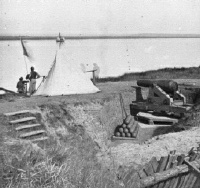 One of my additional duties as a Second Lieutenant in the Wing Intelligence Office was preparing the monthly history, which consisted largely of relating the activities of the Second Bomb Group as its air crews prepared for the assigned war-time mission with forty five Boeing B-50 aircraft. During 1950, I also prepared and presented briefings for the Commanding General, who was a member of a group of businessmen who were interested in promoting and maintaining good public relations between the Air Force and the people of Savannah.
One of my additional duties as a Second Lieutenant in the Wing Intelligence Office was preparing the monthly history, which consisted largely of relating the activities of the Second Bomb Group as its air crews prepared for the assigned war-time mission with forty five Boeing B-50 aircraft. During 1950, I also prepared and presented briefings for the Commanding General, who was a member of a group of businessmen who were interested in promoting and maintaining good public relations between the Air Force and the people of Savannah.
While I was growing up in New York City in the nineteen thirties, I had read a book which described the attack by Union forces in December 1864 on the Confederate Fort McAllister near Savannah during the Civil War, but I could not remember exactly where it was located. During a discussion with one of the members of the General's group of friends after I had presented a briefing, I found out that the fort was located on the Ford Plantation, south of Savannah, near Richmond Hill on the Ogeechee River. Many years before, Henry Ford had bought a few thousand acres in the area where his engineers grew various plants for use as products in the manufacture of his vehicles.
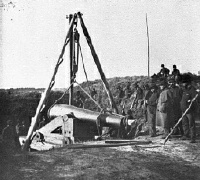 On a beautiful Sunday in the spring of 1950, Mary Ellen and I drove down to Richmond Hill on US Highway 17, in our 1947 Ford two door sedan. We parked in the driveway of the house marked "Plantation Overseer," and I knocked on the front door. A man came out and asked what we wanted. I answered that we would like to visit Fort McAllister, and then he asked, "Why?" When I replied, "My name 1s McAllister." It was evidently the correct answer. He disappeared for a minute, and came back with a large bunch of keys on a ring. He told us that the plantation was divided up into fields some of which contained prize bulls, and others contained cows . The road to the fort went through these fields. He emphasized that each fence separating the bulls from the cows had a padlock which had to be unlocked before our car passed through into the next field, and locked again afterwards.
On a beautiful Sunday in the spring of 1950, Mary Ellen and I drove down to Richmond Hill on US Highway 17, in our 1947 Ford two door sedan. We parked in the driveway of the house marked "Plantation Overseer," and I knocked on the front door. A man came out and asked what we wanted. I answered that we would like to visit Fort McAllister, and then he asked, "Why?" When I replied, "My name 1s McAllister." It was evidently the correct answer. He disappeared for a minute, and came back with a large bunch of keys on a ring. He told us that the plantation was divided up into fields some of which contained prize bulls, and others contained cows . The road to the fort went through these fields. He emphasized that each fence separating the bulls from the cows had a padlock which had to be unlocked before our car passed through into the next field, and locked again afterwards.
We carefully followed his instructions, and after a half hour we arrived at an area which could only be a Civil War fort. There were earthen mounds from which grew sizeable pine and oak trees. In some of the existing revetments, ancient smooth bore cannon were still located. There were brick shelters covered with earth scattered through the area. We spent a while walking around, taking it all in. It was a quiet place. We found a grassy area under some huge oak trees, where the shade and the cool breeze from the river made for a comfortable place for our picnic. I took a lot of pictures with my camera. All in all we spent a delightful afternoon at a place that I had been wanting to visit for many years.
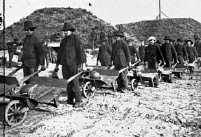 A few years later, I read that the Ford Plantation had been closed and that the land had been given to the State of Georgia, which was going to develop it as a State Park. On our next visit to Mary Ellen's family in Savannah, we went to the office at Fort McAllister from which the restoration project was directed. The supervisor got very interested when I told him that I had some pictures taken in 1950. He asked for copies of my pictures, since the fort had been vandalized after the Ford Plantation was closed, and before the state had taken over the property. A few years later, we visited the completed project and were very pleased to note that my pictures were prominently displayed. The state park has become a very popular place to visit.
A few years later, I read that the Ford Plantation had been closed and that the land had been given to the State of Georgia, which was going to develop it as a State Park. On our next visit to Mary Ellen's family in Savannah, we went to the office at Fort McAllister from which the restoration project was directed. The supervisor got very interested when I told him that I had some pictures taken in 1950. He asked for copies of my pictures, since the fort had been vandalized after the Ford Plantation was closed, and before the state had taken over the property. A few years later, we visited the completed project and were very pleased to note that my pictures were prominently displayed. The state park has become a very popular place to visit.
In the past few weeks, I have been reviewing various data bases for items of interest to the Clan McAlister of America. I found on the Library of Congress web page a number of McAllister photographs which were retrieved by a query on the name. These images included a number of daguerreotypes of people in the W16 (William McAllister) family line, which unfortunately were not digitized. The Fort McAllister images were digitized and are included in this article. They were taken in 1864 and 1865, after its occupation by Union forces commanded by General Sherman.
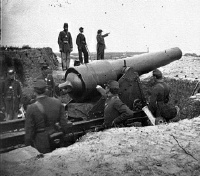 The CMA Web Page currently includes an article about an assault on Fort McAllister, from the February 13, 1863 issue of the New York Times. The map on Page One shows the location of Fort McAllister at a bend in the Ogeechee River, south of Savannah. This series of engagements was undertaken by the Union Navy in an attempt to capture or destroy the Nashville, a Confederate blockade runner, which had gone up the river in late 1862 to escape capture. The first serious attack was on January 27, 1863, and the second was on February 3, 1863. The heavy gunfire from Fort McAllister caused some damage to the Union monitor Montauk, and other ships in the squadron, resulting in a withdrawal from the vicinity. Despite the damage to the Montauk, gunfire from the Union Navy destroyed the Nashville. However, the Union ships could not get upriver past the fort. The fort did not fall to the Union forces until December 1864, when it was taken by Sherman's Army in a land assault, during his famous (infamous?) march through Georgia.
The CMA Web Page currently includes an article about an assault on Fort McAllister, from the February 13, 1863 issue of the New York Times. The map on Page One shows the location of Fort McAllister at a bend in the Ogeechee River, south of Savannah. This series of engagements was undertaken by the Union Navy in an attempt to capture or destroy the Nashville, a Confederate blockade runner, which had gone up the river in late 1862 to escape capture. The first serious attack was on January 27, 1863, and the second was on February 3, 1863. The heavy gunfire from Fort McAllister caused some damage to the Union monitor Montauk, and other ships in the squadron, resulting in a withdrawal from the vicinity. Despite the damage to the Montauk, gunfire from the Union Navy destroyed the Nashville. However, the Union ships could not get upriver past the fort. The fort did not fall to the Union forces until December 1864, when it was taken by Sherman's Army in a land assault, during his famous (infamous?) march through Georgia.
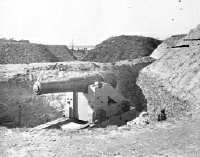 Fort McAllister was built on land owned by Joseph Longworth McAllister (A04-2-4-2-5), a son of George Washington and Mary Bowman McAllister. George was a son of Archibald and Elizabeth Carson McAllister. When George was a nineteen year old student at Princeton College in New Jersey, he decided to leave his father's home at Fort Hunter, Pennsylvania. Taking his portion with him, he traveled by horse to Georgia, finally deciding to settle near Savannah. He bought a large plantation in Bryan County, twenty five miles below Savannah, which he called "Strathy Hall." Fort McAllister, near the mouth of the Ogeechee River, was situated on his son, Joseph's,
Fort McAllister was built on land owned by Joseph Longworth McAllister (A04-2-4-2-5), a son of George Washington and Mary Bowman McAllister. George was a son of Archibald and Elizabeth Carson McAllister. When George was a nineteen year old student at Princeton College in New Jersey, he decided to leave his father's home at Fort Hunter, Pennsylvania. Taking his portion with him, he traveled by horse to Georgia, finally deciding to settle near Savannah. He bought a large plantation in Bryan County, twenty five miles below Savannah, which he called "Strathy Hall." Fort McAllister, near the mouth of the Ogeechee River, was situated on his son, Joseph's, 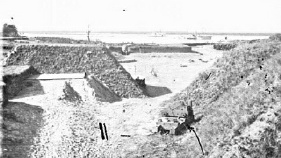 plantation and was named for him. The area was called "Jeneses' Point" by the family and "Genesis Point" by every one else. Joseph Longworth McAllister was killed on June 11, 1864 (his gravestone in Lousia Co., VA), while serving as the colonel of his Confederate cavalry regiment at the Battle of Trevilian's Station, near Louisa Court House, Virginia. It was one of the largest cavalry battles of the Civil War, involving forces commanded by Confederate General Wade Hampton and Union General Phil Sheridan. There were a total of 2,349 casualties at this battle, including 209 killed. If you happen to be driving on Interstate 95 in Georgia near Savannah, take the exit for State Route 144 east through Richmond Hill to the Fort McAllister State Park. After touring the visitors' center and fort, find a picnic table under a live oak tree and enjoy the view of the river through the Spanish moss.
plantation and was named for him. The area was called "Jeneses' Point" by the family and "Genesis Point" by every one else. Joseph Longworth McAllister was killed on June 11, 1864 (his gravestone in Lousia Co., VA), while serving as the colonel of his Confederate cavalry regiment at the Battle of Trevilian's Station, near Louisa Court House, Virginia. It was one of the largest cavalry battles of the Civil War, involving forces commanded by Confederate General Wade Hampton and Union General Phil Sheridan. There were a total of 2,349 casualties at this battle, including 209 killed. If you happen to be driving on Interstate 95 in Georgia near Savannah, take the exit for State Route 144 east through Richmond Hill to the Fort McAllister State Park. After touring the visitors' center and fort, find a picnic table under a live oak tree and enjoy the view of the river through the Spanish moss.